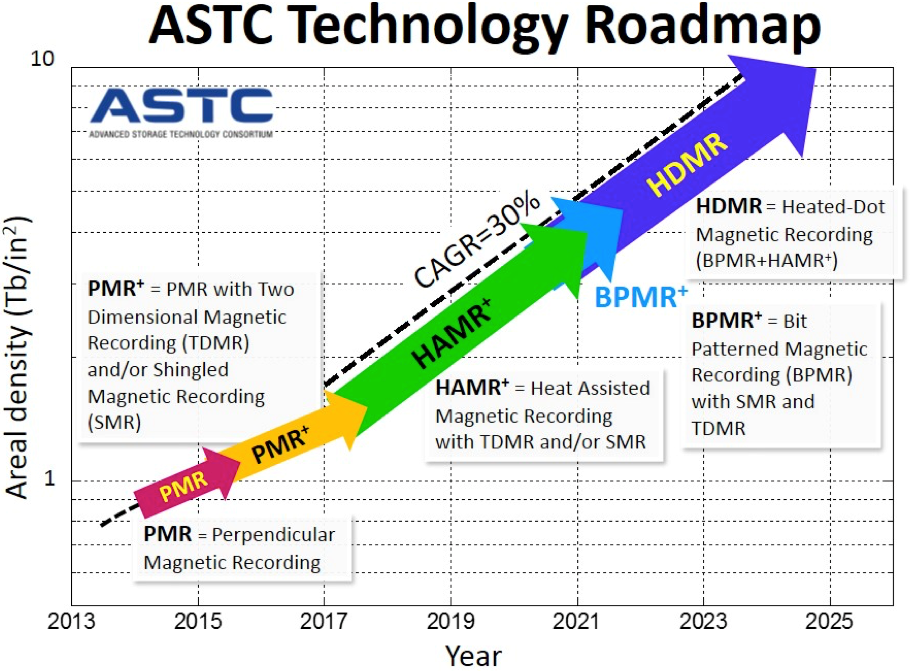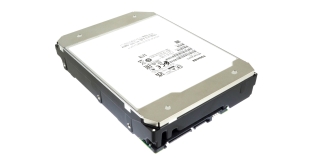At the recent Magnetism and Magnetic Materials (MMM) conference Advanced Storage Technology Consortium (ASTC), which unites numerous makers of hard disk drives as well as developers of storage solutions, demonstrated a new HDD roadmap. Apparently, rapid increases in areal density of hard drive media will allow HDD makers to create hard drives with up to 100TB capacity by 2025.
Modern hard drives use perpendicular magnetic recording (PMR) technology which once enabled a rapid HDD capacity boost, but is no longer quickly evolving. It is also believed that shingled magnetic recording (SMR) technology will not bring a lot of capacity benefits to hard drives as well, according to the roadmap. Members of ASTC believe that the next big thing in hard disk drives is heat assisted magnetic recording (HAMR), which will be massively introduced into HDDs by 2017, increasing the average annual areal density growth rate to 30% (it is currently about 15%), reports Forbes.
At present advanced hard drive media features 0.86Tbpsi (Terra-bit per square inch) areal density. HAMR technology is projected to increase it to 2Tbpsi – 4Tbpsi in the coming years, thus significantly increasing capacities of hard drives to 20TB+ in the next five years.
Sometimes in 2021 the industry is expected to migrate to bit pattern media (with the magnetic media broken into small regions on the disk surface) combined with an extension to SMR called two dimensional magnetic recording (TDMR).
Eventually bit pattern media with TMDR will be combined with HAMR – which will be called heated-dot magnetic recording, or HDMR – boosting areal densities to 10Tbpsi by 2025. Thanks to storage media with 10Tbpsi areal densities, it will be possible to build 100TB+ hard drives a little more than 10 years from now.
While solid-state storage is rapidly catching up with hard disk drives in terms of capacity these days, it remains to be seen whether companies like Intel, Samsung, Toshiba or Micron will be able to continue to keep the pace once HAMR and BPMR technologies enter the market.
Discuss on our Facebook page, HERE.
KitGuru Says: Looks like hard drives will continue to be used as primary storage devices for huge amounts of data for at least another decade…
 KitGuru KitGuru.net – Tech News | Hardware News | Hardware Reviews | IOS | Mobile | Gaming | Graphics Cards
KitGuru KitGuru.net – Tech News | Hardware News | Hardware Reviews | IOS | Mobile | Gaming | Graphics Cards




10 years, yeah right. Be lucky we have 25TB drives by then.
Lol too long. I might have died then lol…
We need to focus less on harddrive size and more on harddrive speed so that it can catch up to SSD’s instead of the other way around. Who needs 100TB of data? While storage size continues to grow program sizes grow also solely for the reason of: “Because we can”. Just remember 10-20 years ago we were using 80-200GB harddrives and it was fine.
Here’s something I document for sometime now, how long I wouldn’t be able to tell, I always keep note of future hardware to come. By 2020 well be rocking 20TB and when that time comes watch out Bly-ray movies.
Seagate, TDK Demo HAMR Tech for Next-gen Hard Drives
At CEATEC between October 1 through October 5 2013 in Japan, Seagate Technology and TDK are demonstrating HAMR technology, heat-assisted magnetic recording. This system uses a laser to first heat the platter before magnetically recording data, enabling the drive to write bits of data closer together so that even more data can be stored than when using the standard method.
Currently shipping leading-edge shingled magnetic recording technology (SMR), Seagate will continue to push the limits of storage capacities with HAMR in an effort to fulfill the insatiable global demand for storage fuelled by cloud and mobile usage. Critical for continued improvement in areal density, HAMR increases storage capacity by heating the medium with a laser-generated beam at the precise spot where data bits are being recorded. When heated, the medium becomes easier to write and the rapid subsequent cooling stabilizes the written data. The result of this heat-assisted recording is a dramatic increase in the recorded density.
HAMR, combined with self-ordered magnetic arrays of iron-platinum particles, is expected to break the limit of magnetic recording by more than a factor of 100 to ultimately deliver storage densities as great as 50 terabits per square inch. To put this in perspective, a digital library of all books written in the world would be approximately 400TB meaning that in the very near future conceivably all such books could be stored on as few as 20 HAMR drives.
During the show, Seagate is demonstrating a HAMR-based 2.5 inch 10,000 RPM drive designed for enterprise blade servers in TDK’s booth. Seagate’s Chief Technology Officer Mark Re told the IDG News Service on that the company is shooting to actually begin delivering HAMR drives in 2016. The tech has only been in active development at the company since around 2005, which is a shorter time frame than the ten+ year period NAND flash used.
The typical hard drive is expected to hit a wall on data density when the tech reaches 1 terabit per square inch per platter – the standard now is 750 gigabits per square inch. This barrier is due to the substrate’s cells that can become unstable and change polarity when they become smaller. Data is stored by changing the magnetic polarity of the cell.
But with the HAMR technology, the HAMR head heats up only the area where the data is to be written, allowing Seagate to use a different kind of disk media with higher coercivity, or the ability for the cells to hold the magnetic charge with which they’ve been set. Seagate expects to break the 1 terabit ceiling and reach as high a 5 terabits per inch. This would enable 20TB hard drives by 2020.
Mark Re said that attaching and aligning a semiconductor diode laser to an HDD write head and then implementing near-field optics to deliver heat have been some of the biggest challenges in developing the HAMR technology. Although near-field optics isn’t anything new, hard drives would be the largest volume implementation of the tech thus far.
He also added that the cost of HAMR-based drives will likely be the same price as drives sold today 2013. They also won’t significantly increase power consumption because the laser merely consumes tens of milliwatts of additional power. The company is demonstrating the 10,000 RPM hard drive to assure skeptics that the technology works, and should become marketable in the next several years.
They’re trying to ward off the skeptics. The technology is very, very difficult, and there has been a lot of skepticism if it will ever make it into commercial products, said IDC’s John Rydning, adding that the consensus in the HDD industry seems to be that HAMR won’t ship before 2017.
Again I don’t know were I got this from because I didn’t include the link.
PhoneyVirus
https://twitter.com/PhoneyVirus
https://phoneyvirus.wordpress.com/
theyve just realeased 8 and 12TB drives, and ssds are starting to chip stack so i see it happening sooner
20 years ago youre lucky to have had a 1GB hdd let alone 200GB
I really doubt it, at least not for regular consumers. I bought a 2 terra byte seagate in 2011 for like 100$ (and yes ok it was a green disk, they are cheapish) but skip 4 years to 2015, the 2 terra still more or less costs the same, 4 and 6 terras are still expensive. And DDr3 ram(although not related) we have been usign them for 8 years. The industry will not give us new tech if it is not profitable…
No. SSD are for speed and hard disks are for storage. I keep a very slow large storage which I need for my backups and data that I rarely use(and they fill more than 2 terrabytes), and I have an ssd for things I use daily(and hourly) and my storage needs keep increasing. We need to focus on ssd size, that would eb the perfect world, hard disks cannot become as fast as ssd because they rely on spinning, and physical movement has weak limits.